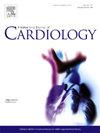Correlation between workload-indexed blood pressure response to exercise (SBP/MET slope) and clinical and echocardiographic parameters among normotensive Olympic athletes
IF 3.2
2区 医学
Q2 CARDIAC & CARDIOVASCULAR SYSTEMS
引用次数: 0
Abstract
Introduction
The workload-indexed systolic blood pressure response to exercise (SBP/MET slope) has been proposed as a novel parameter for evaluating abnormal blood pressure response to exercise (ABPR) and its potential risks.
Aim of our study was to assess the association between SBP/MET slope and clinical and cardiac dimensional parameters in normotensive athletes.
Methods
A cohort of 292 normotensive Olympic athletes (155 male, 53.1 %) underwent a pre-participation evaluation that included clinical, echocardiographic, and exercise-stress test parameters. The SBP/MET slope was calculated as the increase in systolic blood pressure indexed to metabolic equivalents achieved during maximal exercise. Athletes were stratified into quartiles based on their SBP/MET slope, and comparisons across quartiles were made.
Results
Athletes in the highest SBP/MET slope quartile exhibited increased left ventricular wall thickness, i.e., interventricular septum (IVS) compared to those in lower quartiles (10.3 ± 0.9 vs. 9.5 ± 1.1, p = 0.014). Male athletes predominated in higher quartiles (p = 0.047), and endurance athletes were absent in the higher groups (p = 0.006). No differences were observed for systolic or diastolic function across quartiles. At multivariate analysis, SBP/MET slope was indipendently correlated to IVS (p = 0.040; R2 = 0.566, standardized beta coefficient = 0.368) and inversely correlated to W/Kg (p = 0.014; R2 = 0.566, standardized beta coefficient = −0.507). After a follow-up of 10.3 ± 2.6 years, 13.6 % of athletes in the highest quartile developed hypertension.
Conclusion
Athletes with higher SBP/MET slope exhibited increased wall thickness and lower exercise capacity and showed higher risk for late-onset hypertension.
Long-term follow-up studies are warranted to further elucidate its prognostic implications.
求助全文
约1分钟内获得全文
求助全文
来源期刊

International journal of cardiology
医学-心血管系统
CiteScore
6.80
自引率
5.70%
发文量
758
审稿时长
44 days
期刊介绍:
The International Journal of Cardiology is devoted to cardiology in the broadest sense. Both basic research and clinical papers can be submitted. The journal serves the interest of both practicing clinicians and researchers.
In addition to original papers, we are launching a range of new manuscript types, including Consensus and Position Papers, Systematic Reviews, Meta-analyses, and Short communications. Case reports are no longer acceptable. Controversial techniques, issues on health policy and social medicine are discussed and serve as useful tools for encouraging debate.
 求助内容:
求助内容: 应助结果提醒方式:
应助结果提醒方式:


